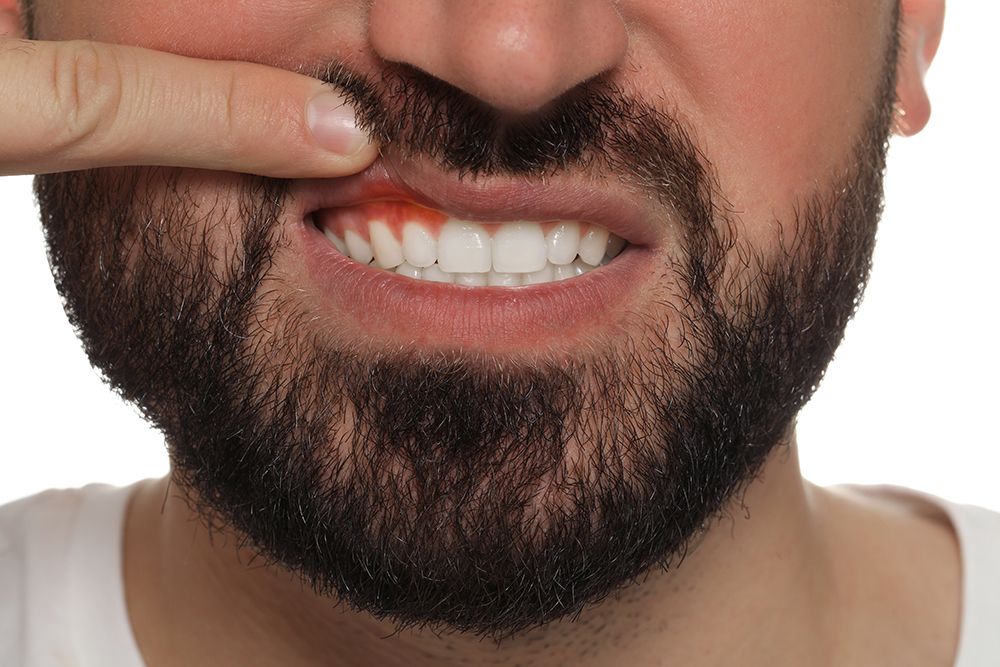Study Indicates Gum Inflammation Parallels “Cytokine Score”
Higher levels of cytokines in saliva match greater gum inflammation, according to research conducted by the NYU College of Dentistry.
NEW AFRICA / STOCK.ADOBE.COM

Researchers at NYU College of Dentistry have developed a single score to describe the level of cytokines in the saliva, and this score is linked with the severity of clinical gum inflammation, according to a study published in the journal PLOS ONE.
Additional research is needed, but if the cytokine score is validated in larger and more diverse patient populations, it could be used to better understand periodontal disease progression and recurrence, as well as the potential connection to other systemic conditions, according to the NYU College of Dentistry.
The “cytokine score” could hold promise in the future for measuring how well a patient responds to treatment for gum disease, predicting gum disease recurrence, or detecting ongoing inflammation related to systemic diseases.
“Periodontal inflammation is not just apparent upon examination, but is reflected in the patient’s saliva,” Angela Kamer, DMD, MS, PhD, associate professor of the Ashman Department of Periodontology & Implant Dentistry at NYU Dentistry and the study’s senior author, says in a press release.
Periodontal disease is a chronic, inflammatory condition that affects roughly half of adults. Marked by inflamed gums, which can bleed and detach from the tooth, periodontal disease results from the complex interaction between an imbalance of healthy and unhealthy bacteria under the gumline and the immune system’s response. This response produces high levels of cytokines—small proteins that signal the immune system—in the inflamed gums, especially pro-inflammatory cytokines such as IL-8, IL-1β, IL-6 andTNFα.
Periodontal disease is also known to be associated with systemic conditions including cardiovascular disease, diabetes, and Alzheimers. Scientists believe that gum inflammation contributes to these conditions through both indirect pathways (cytokines boosting systemic inflammation) and direct pathways (cytokines traveling to a specific organ like the heart or brain), but studying this is difficult due to the challenge of measuring cytokines in the fluid found deep in the pockets in the gums.
Fortunately, cytokines are also found in the saliva, which is easier to collect. In the PLOS ONE study, the researchers wanted to know if clinically detected gum inflammation could predict the level of cytokines found in saliva. PLOS ONE is an inclusive journal community working together to advance science for the benefit of society, now and in the future.
“Salivary cytokines are a window into the molecular make-up of the oral environment,” says Vera Tang, DDS,MS, clinical assistant professor of the Ashman Department of Periodontology & Implant Dentistry at NYU Dentistry and the study’s first author.
The researchers evaluated the gums and saliva of 67 adults, ages 45 and older, who had some degree of periodontal disease but were otherwise healthy. To measure their clinical periodontal inflammation, the researchers used a formula called the Periodontal Inflamed Surface Area (PISA), which is calculated using measurements of the depth of pockets in the gums and bleeding upon probing. PISA provides a single measure of periodontal inflammation; a higher PISA score indicates worse inflammation.
Participants were also asked to spit into sterile tubes to capture saliva samples, which were then analyzed to measure a range of both pro- and anti-inflammatory cytokines: IL-1β, IL-6, IL-8, IL-13, TNF-α, and IL-10. Led by statistician Malvin Janal, PhD, the researchers used 2 different ways (the Cytokine ComponentIndex and Composite Inflammatory Index) to combine these cytokines into a single score.
They found that PISA scores were significantly associated with the new cytokine scores, independent of other factors including age, gender, smoking, and body mass index (BMI). The higher a cytokine score, the greater the periodontal inflammation.
Related reading: New Study Indicates Oral Bacteria May Increase Heart Disease Risk
“This demonstrates that a single score encompassing several salivary cytokines correlates with the severity of periodontal inflammation,” says Leena Palomo, DDS, MSD, professor and chair of the Ashman Department of Periodontology & Implant Dentistry at NYU Dentistry, and a study coauthor.
The researchers caution that more research is needed to validate the cytokine score in patients with different health conditions, as well as those with all levels of periodontal disease, including healthy gums and early-stage gum disease. However, if the cytokine score is validated in larger and more diverse patient populations, it could be used to better understand periodontal disease progression and recurrence, as well as the potential connection to other systemic conditions.
“With treatment for gum disease, such as scaling and planing, we know that the PISA score goes down. It would be interesting to see if the cytokine score also drops—or, if it persists, look into what that means,” adds Dr Kamer. “Is it picking up an underlying cause, like ongoing inflammation from systemic disease? Or if someone has a hyperinflammatory response, which we’d know from a high cytokine score, can it predict if periodontitis will recur or progress in the future? We hope to look into these questions in future research.”
Additional study authors include Babak Hamidi, DDS, MPH; Cheryl Barber, MS, MPH; and Benjamin Godder, DMD, of NYU Dentistry. This research was funded by the National Institutes of Health (R03-DE023139).